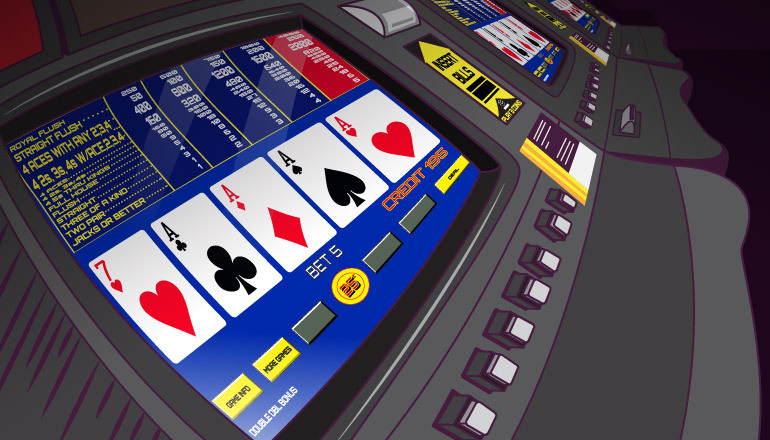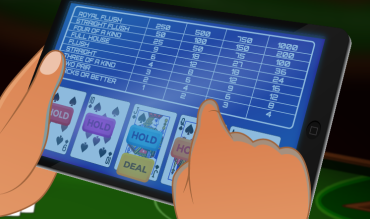In video poker, open straights are a common hold. However, inside straights are a very uncommon hold. Therefore, it makes sense for a serious, or even casual video poker player to make sure he or she knows just exactly comprises an open straight.
While most seasoned video poker players well understand the difference and may not feel they need to revisit this topic, it never hurts to be sure.
Contents
- Definition of open and inside straights
- What are fully open straights?
- Why it matters
- Samples and quiz
- Summary
Definition of open and inside straights
Look at the strategy for just about any video poker game and you will find two different types of straight – open and straights. The terms open and inside also apply to straight flushes which are simply straights consisting of one suit.
Most players, no matter how casual their play may be, know somewhat instinctively that open straights are good and inside straights are not so good. The phrase “never draw to an inside straight” is classic poker advice.
An open-ended straight is defined as “a sequence of four cards of consecutive rank in which there are two possible card ranks that will complete a straight; as opposed to a one.”
Using this definition a 5, 6, 7, and 8 is an open straight. The 2, 3, 4 and 5 is also an open straight as is the 10, Jack, Queen and King. This is true because the straight can be completed by drawing a card on either end of the sequence. In the first example a 4 or a 9 would complete the five-card straight. In the second example an Ace or 6 would complete the 5-card sequence. And, in the last example, a 9 or an Ace would complete the five-card sequence.
If this article interests you, keep reading. Alternatively, explore other topics like slot machine strategy, how to play roulette, and blackjack side bets.
What are fully open straights?
Many video poker players think of an open straight as any sequence of cards without a gap. They might consider an Ace, 2, 3, and 4 as an open straight.
It is not.
It is true that this is a four-card sequence that does not contain a gap, but it can only be completed by drawing a card at one end of the sequence – a 5. For this reason, this sequence is considered an inside straight. Rather than thinking of an open four card straight (or straight flush) as a sequence of cards without a gap, it is better to think of it as a sequence of cards that can be completed at either end of the sequence. Anything else is an inside straight.
What about three-card straights? The same rules apply. Just because the three cards are in sequence does not automatically qualify the hand as an open straight (flush).
A hand containing a 5, 6 and 7 would be an open straight (flush). It can be filled by drawing the 3 and 4, the 8 and 9 or the 4 and 8. In other words it can be completed by drawing two cards on either end, or one on each end.
A hand containing a 2, 3 and 4 would not be an open straight (flush). It can be completed by drawing a 5 and 6, and by drawing an Ace and 5, but there is only one slot at the low end of the sequence – the Ace.
The same rules apply to a two-card straight (flush). A hand containing a 5 and 6 is an open straight (flush) because it can be completed by drawing the next or previous three cards in the sequence. Specifically, drawing a 2, 3, and 4 or a 7, 8 and 9 will complete the straight (flush). Drawing a 3, 4 and 7 or a 4, 7 and 8 will also complete the straight (flush).
What about a hand containing a 3 and 4? It can be completed by drawing the 5, 6, and 7. It cannot be completed by drawing the three lower cards in sequence as only the Ace and two slots are open.
Hopefully the above explanations and examples are clear to you for that next time you play online or in a casino. Rather than to define and open straight (flush) as a series of cards in sequence, it is much better to define an open straight (flush) as a hand that has a series of cards in sequence AND can completed by filling either end with the total number of slots remaining after discard.

Why it matters
To make video poker play as profitable as possible, dealt hands must be interpreted properly. Improperly determining an inside straight (flush) as an open straight (flush) will reduce the expected return. Take the time to determine that what you are seeing is what you think it is. That will pay dividends in the long run.
Samples and quiz
Here are some hands that feature open and inside straights/straight flushes.
These hands are played on a full-pay (9-for-1 for a full house and 6-for-1 for a flush) Jacks or Better game with the max credits of five.
- The first hand is: 2dAd4dAh5d
This hand contains a high pair (AdAh), and four of an inside straight flush (2dAd4d5d). More often holding a high pair is the preferred play, but in this case, we also have a very powerful straight flush – even though it is an inside straight flush – only one card will complete the hand.
Holding the high pair returns 7.683 credits. Holding the four-card inside straight flush returns 11.915 credits – 50 percent more than the high pair and the much better choice.
- Let’s try another easy one: 2d3d4d5dAh
This hand contains a straight (2d3d4d5dAh), and four of an open straight flush (2d3d4d5d). Four of an open straight flush is a very powerful hand as it can be filled from either end, and if filled, returns 50-for-1. Is that enough to offset the sure 4-for-1 return for the pat straight?
Holding the four of an open straight flush returns 17.234 credits on average – not quite enough to overtake the 20-credit return for the straight.
- This hand is a little closer: 3d4d5dQcJc
This hand has two of a royal flush (QcJc) and three of an open straight flush (3d4d5d). The two of a royal are the strongest there are. Does three of an open straight flush have what it takes to overcome them?
Holding the two of a royal returns 3.123 credits. Holding three of an open straight flush – while still an overall losing hand in the long run – returns 3.15, making it the better hold.
Let’s modify the last hand slightly, changing the three-card open straight flush into a three card inside straight flush.
- The modified hand is: 2d3d4dQcJc
Notice that the three cards of the straight flush are in sequence (2d3d4d). It is not an open straight flush, however, because it cannot be filled by two cards on either end. The 5 and 6 of diamonds will fill it on the high end, but the Ace of diamonds is the only card possible on the low end.
Will this change make a difference in the preferred hold?
Holding the two of a royal flush still returns 3.123 credits. However, holding the three cards of an inside straight flush returns just 2.669 credits. Holding for the royal is a better choice.
How did you do?
Summary
Open straights (and straight flushes) are more powerful than inside straights due to having additional opportunities to fill the straight (or straight flush). The player must be careful to ensure that the open straight is a “fully-open” straight to maximize the return.


